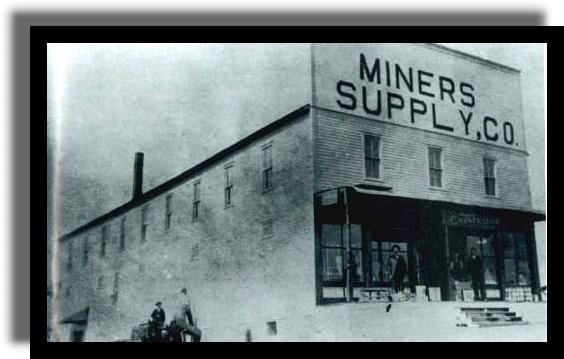

Playing a very important part in the history of the business development of this community were the men interested in the mercantile establishment housed in the building shown above, the Miners Supply Company.
While our informant could not name all of the stockholders, among them were Phil A. Shaw and his son, Harry Shaw, Wm. Estes, W. F. Lawrence, G. M. London, Luther Williams, S. I. D. Smith, and a man named Calvert or Calvird.
The Miners Supply Company building was built by the Shannon Bros. about the year 1900, a furniture and piano store on the first floor and what was then termed an opera hall on the second floor.
The opera hall was at that time the only community meeting place, outside of the churches, and was used for political gatherings, lodge meetings, band concerts, old fashioned melodramas, which were played before interested audiences by both traveling and home talent casts. Not even a temperance play was given in a church house in those days.
There were two entrances to the opera hall, only one, at the left rear, to be seen in the photograph. This was the entrance side, the exit being at the front of the building on the west side. The entrance and exit were different so that in case of fire there would be less confusion.
In the early part of 1902 Shannon Bros. went out of business and the building and its contents were bought by the group of men who organized the Miners Supply Company. This concern sold the furniture and piano stock and restocked with a line of general merchandise, remodeling the opera hall so that a portion of it could be used for storage. The orthodox Jews continued to rent this smaller hall for religious purposes but the melodramas and political gatherings moved uptown to the new opera house.
At the time the picture was was made Phil A. Shaw, father of Harry Shaw of Farmington, was president of the company and W. F. Lawrence was manager of the store. No fresh meats were handled in the general store then, only dry salt bacon and cured meats being sold. If the housewife wanted fresh meat she went to the butcher shop (meat market to the younger generation) where she bought home killed meat, sometimes good and sometimes not so good. Government inspected and government stamped meat was unheard of and most likely not thought about.
At this time the Miners Supply used a wagon and a team of horses for delivery purposes. In the picture Charley Brown, then delivery boy, is holding the lines with W. F. Lawrence, the manager, standing on some boxes and barrels beside the wagon. Brown still lives in Flat River and has been employed by St. Joseph Lead Company for years.
All vegetables, fruits and poultry were bought direct from the farmer who usually took the worth of his produce in trade. If he didn't need as much merchandise as his produce totalled he was given a due bill which was the same as cash at this store when he came to town again to make purchases. Nearly everyone bought on credit and instead of duplicate sales slips as used today, each customer was given a book, much like a large bank book, which he carried to the store each time a purchase was made and that purchase was entered, along with the date, in this customer's book while the same entry was made in the merchant's day book which was later posted in a large account book on that customer's page. When the bill was paid a big sack of candy for the children, a black cigar for the head of the house (and then that meant the husband) and sometimes chewing gum were given as a treat.
No telephone orders were taken because only a few families had access to a telephone. At the extreme right of the picture on the right side of the street will be seen a few telephone poles where there were two or three houses. The left side of what is now High Street had no residences at all.
In 1911 A. C. Crews was made manager of the company and retained the management until the company was dissolved, the merchandise and building being sold at public auction. M. Fox bought the building, renting the basement to a produce company, the first floor to a grocer, using the opera hall for living quarters and the barn for storing junk and automobile tires.
Fire destroyed the building in 1921 and John Ball bought the lot and had the present building, occupied by a H. E. Francis Store, built.
The above story was written as accurately as could be obtained and if some facts are not quite correct it is because Time has dimmed the memory of the narrator.
The information on this site is provided free for the purpose of researching your genealogy. This material may be freely used by non-commercial entities, for your own research. The information contained in this site may not be copied to any other site without written "snail-mail" permission. If you wish to have a copy of a donor's material, you must have their permission. All information found on these pages is under copyright of Oklahoma Cemeteries. This is to protect any and all information donated. The original submitter or source of the information will retain their copyright. Unless otherwise stated, any donated material is given to MOGenWeb to make it available online.